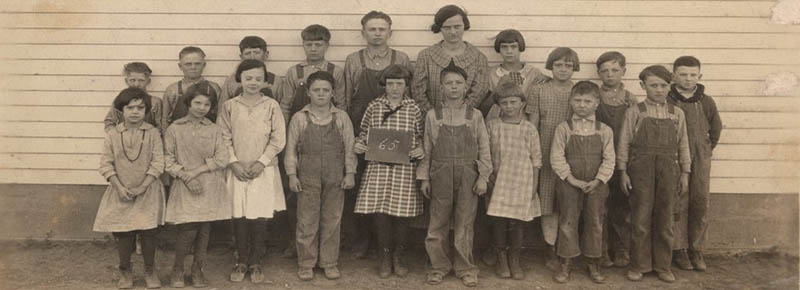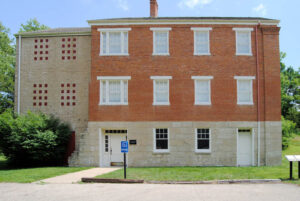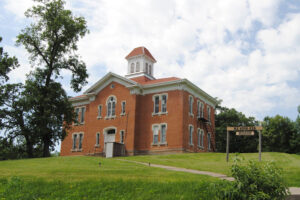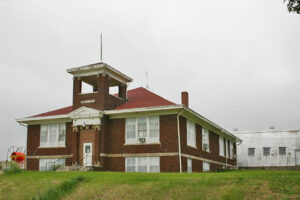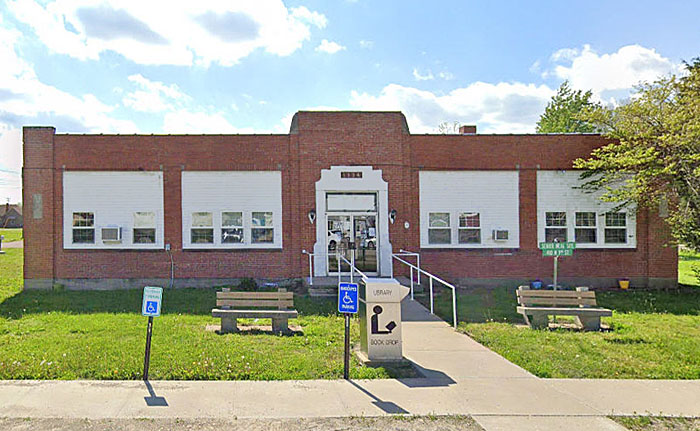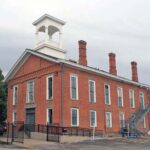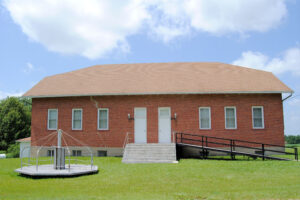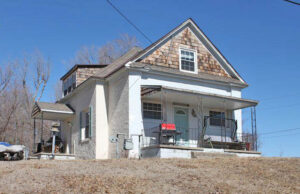In 1837, the Presbyterian Board of Missions planted a mission under the hands of Reverend S.M. Irvin among the Sac and Ioway Indians. These tribes’ lands occupied what are now Doniphan and Brown Counties. Several grammar and textbooks in the Indian language were set up and printed, and Reverend William Hamilton and Reverend S.M. Irvin did the literary and typographical work.
In 1854, a treaty was made with the Indians, removing their claims from this part of their lands, and the country was opened for settlement.
Doniphan County, Kansas, was organized in 1855. In May 1857, a little school began in a log cabin where the town of Highland now stands. Two ministers, two elders, and a dozen students made up the first session of that school. The following year, the log cabin was exchanged for a neat and comfortable frame building, and the schoolhouse became a Presbyterian academy. In 1858, a liberal charter from the Territorial Legislature was obtained under the title of Highland University Company. In 1866, a large brick building was built for $4,000.
The average yearly enrollment of this school for some years was about 100 students, and among its graduates were men of prominence, ability, and integrity.
John Bayless was the first superintendent of public instruction in Doniphan County in 1859 and served for four years. Arriving in Kansas in 1855, he was public-spirited and interested in developing the new state. He organized school district No. 1 at Wathena on April 21, 1859. Benjamin Harding, the first teacher legally licensed to teach in the county, took charge of the school. A frame building was erected for school purposes in 1857, and the school was maintained up to the time of organization. During his tenure, Bayless organized 21 school districts in Doniphan County; the last, 21, was attached to the district, which included Troy, the county seat.
In 1863, Mr. C.C. Camp was placed in charge of the schools. He was the district attorney at the time. He was appointed first and afterward elected to the office of county superintendent of public instruction, with the understanding that he would be expected to do as little as possible and keep the schools going. During the four years he held office, he organized 20 school districts, making 41 numbers, but some had lapsed. Mr. Camp was paid from $36 to $50 per annum and very modestly said he thought they paid him well for all his services.
“Teachers were so scarce that I had to be careful not to reject anyone sent by a school board for examination. One incident in this connection I well remember. A school district sent for examination a man whom I had long known as a wood chopper and teamster. I commenced his examination, with many misgivings, by asking with what branch he was best acquainted. He said he was something of a mathematician, so I followed this lead. He readily answered all questions about the primary rules of arithmetic, showed a perfect knowledge of fractions, explained all the intricacies of decimals, percentages, and interest, and gave the rule of square root. I asked him to give the reason for this rule. He immediately did so, and I immediately gave him his certificate.
A large part of the original population of Doniphan County came from the Southern States, and many of them were opposed to being taxed to support schools. So many Union men were away in the army that, in one instance, they voted against the tax and closed the schools. In this emergency, they came to me. I told them to rally the war widows and let them vote in place of their husbands. From that time forward, no schools were closed for want of tax levy.”
— C.C. Camp, Doniphan County School Superintendent
In 1867, Reverend Gary Hickman, a Presbyterian minister who was highly educated yet eccentric, was elected county superintendent. He called it the first institute ever held in the county in 1867. It was held in the Methodist Episcopal Church in Wathena, and the teachers sat on board benches. D.W. Brown, from Troy, Reverend T.H. Dinsmore, and three or four others from Highland went and formed an institute with the Wathena teachers. He held the office until May 1868, when he resigned, and Mr. D. W. Brown was appointed to succeed him. He was a practical schoolman and served four years and four months. During this period, he devoted his entire time to the work.
The educational affairs of Doniphan County, in common with those of other places, were in poor condition. There were no records in the office; the county was imperfectly districted; the textbooks used were a mixture of everything published at the time. Mr. Brown arranged with Wilson, Hinckle, & Co. of Cincinnati, Ohio, to bring uniformity. The company furnished the books gratis, exchanged new ones for old, and paid the freight both ways. Mr. Brown brought around the new books and took away the old ones. Several new districts were organized, and the boundaries of many more were changed. Many new schoolhouses were erected, and many more were improved, reseated, and furnished with appropriate apparatus.
He held “institutes,” as they then called them, of one week’s length, usually in August each year, at Troy, Wathena, White Cloud, and Highland. In these institutes, the teachers did their best with what they had to do with. No funds were provided. The teachers acted as volunteer instructors and were all entertained by the town’s citizens with genuine, open-hearted hospitality. They had a good time, exchanged methods, instructed each other, and all felt the good results. The examinations, usually written and at stated times, were conducted by an examining board.
Mr. Brown said he left the teachers, as a class, much improved. This, in part, was due to immigration. He made a complete record of the districts as he found them and as he left them. He made many changes. He did it without consulting policy or public opinion and was frequently criticized and often unjustly blamed. Those who knew most of his work considered him one of the best schoolmen who have been in the county. He was a native of Vermont and lived near Troy. Due to ill health, he resigned in September 1872, when D.D. Rose succeeded him.
Mr. Rose held the office for six years and four months, carrying on the work left by his predecessor. He began teaching at 19 years of age, continued in this work until the war, and served the entire time as a soldier. He came to Doniphan County in 1866. Mr. Rose held short institutes at East Norway, Highland, Severance, and White Cloud, and in 1877, he held the first annual normal institute of one month at Troy in August. It was conducted by Professor John Wherrell, assisted by J.A. Lane and Miss Wherrell, and enrolled over 100 teachers. The normal institute met with great favor. The young teacher was better prepared for their work, and it brought new methods and professional insight to the more experienced teacher.
The normal institute of 1878 was conducted by Professor H. D. McCarty, assisted by J A. Lane. Township associations had been organized as early as 1871. In Iowa and Wolf River Townships, they were especially successful. They met every two weeks at different schoolhouses. On Friday night, there would be a gathering for a lecture and some discussions, and on Saturday, the teachers spent the day in class drills. Mr. Rose was succeeded in 1879 by Mr. Edward Heeney, who conducted the affairs of the office with vigor and ability. In August 1879, the institute was conducted by Professor McCarty, assisted by O. C. Hill. This was one of the largest ever held in the county, having on the roll 140 names. During the session, the Doniphan County Teachers’ Association was organized. Mr. Edward Heeney was chosen first president. This county teachers’ association has had its seasons of prosperity and adversity but has had its regular meetings each year and has been a significant factor in the growth of the school work.
Professors McCarty, Hill, and B. F. Nihart conducted the institute in 1880. Mr. Heeney went down with his party in 1881. He has the honor of being the only Democrat to hold this office in Doniphan County. He is a county native and still remains here, handling not only boys and girls but also other hardware.
Mr. H. F. Shaner, in 1881, took up the work and zealously and skillfully managed it for six years. He was Pennsylvanian by birth but had been actively engaged in the county’s school work for 12 years. His energy and public spirit, which he had shown as a teacher, served him well in a higher capacity. The county associations were largely attended, and the schools were carefully supervised. He encouraged teachers to read professional literature and organized a teachers’ reading circle, which was moderately successful for two years. He set up a high standard before the teachers. The work of these six years is highly estimated. Mr. Shaner married one of the best teachers and left the profession. He lives in Chicago, engaged in railroad work.
He was succeeded by Oliver Edwards, another Pennsylvanian, a graduate of Lebanon College, Ohio, a professional teacher, and an old soldier. During the two years of his term, his ability and upright life impressed themselves upon the work and all who knew him. He died upon the eve of his reelection in November 1888 and was succeeded by A.R. Graves by appointment. Mr. Edwards first published the association program for the entire year. This outlined the work ahead; consequently, the teachers were better prepared.
Mr. Graves laid out plans for the better gradation of county schools. On November 19, 1889, the teachers and his successor in office, Miss Frances E. Katner, took up this earnestly and proved a most helpful move. The schools were brought into a better system, the required studies were placed in all the schools, and graduation from the country schools was introduced.
A reading circle was organized in 1881, with 70 members, and one in 1892, with 50 members. Associations are generally well attended.
For the year ending June 30, 1892: School population between 5 and 21 years, 4,716; number of different students enrolled, 3,537; average daily attendance, 2,108; number of districts organized, 69; number of clerks reporting, 68; number of teachers, male 41, female 46, total 87. The average length of the term was 28 weeks; the average number of mills levied for school purposes was 11.2; the number of persons examined was 75; the number of applicants rejected was 9; the number of first-grade certificates granted was 13; the number of second-grade certificates granted, 29; the number of third-grade certificates granted, 19; the number of temporary certificates granted, 5; the average age of persons receiving certificates, 23.5 years; the number of teachers employed holding State certificates 2, first grade 28, second grade 42, third grade 15, total 87; average salary paid male teachers, $44.60; average salary paid female teachers, $39.15; the estimated value of school property, $80,000; bonded indebtedness, $4,800; receipts by treasurers for the school year, $40,058.86; amount expended for school purposes, $34,875.63; balance in the hands of district treasurers, $5,183.23; amount institute fund received, $302; amount institute fund expended, $257.75; amount institute fund on hand, $44.25.
The library movement of 1893 was the newest and most popular wave of educational change in the county in a long time.
Historic Schools of Doniphan County
| Name | District | Years of Operation | Location & Information |
| Bendena | 81 | 1917-?? |
This one-and-a-half-story red brick building has its original windows and a Quonset hut behind the school that was erected for the gymnasium. It sits at 887 Friendship Road, one-half mile south of Bendena on 887 Friendship Road, 1/4 mi. S of Bendena on T218. |
| Eclipse | 59 | 1895-1966 |
The Eclipse School was built in the Folk Victorian style approximately one-half mile north and one-and-half miles east of Troy in Doniphan County, Kansas, on Ottumwa Road. It had 32 students in the Spring of 1896 and 51 in 1936. It was closed with school consolidation in 1966. It was listed on the National Register of Historic Places in March 1988. However, the building was relocated to 210 Roseport Road in Wathena, altered, and was removed from the register in December 2004. It currently serves as a church. |
| Lincoln Grade School | 2 | 1935-1955 |
The one-story red brick Art Deco-style old Lincoln Grade School was Built in time for the 1935-1936 school year. It was in operation until May 1955, when the district was integrated. The building is leased to the Elwood Senior Citizens Center and Library District #1. It is located at 410 North 9th Street in Elwood, Kansas. |
| Irvin Hall | NA | 1858 |
Irvin Hall, Highland Community College is the oldest college building still in use in Kansas. When the town of Highland was established in 1857, one of the first objectives was establishing a university site. Work on the first building, Irvin Hall, began in 1858. Highland was among the first communities in Kansas Territory, and Highland University was the first college in Kansas. Missionaries from the Presbyterian Church established Highland University. It evolved, losing its affiliation with the Presbyterian Church, having seven name changes, gaining local support, and becoming a regional rural community college. It is located at 602 W. Main Street in Highland, Kansas. |
| Purcell | NA | ?? |
This school was probably connected with the Catholic Church. |
| Troy Colored Grade School | ?? | 1900-?? |
Although black and white students were educated together in the 1880s, by 1900, the Troy school board felt it necessary to build this school for black students. However, Troy High School has always been integrated. The old Troy Colored Grade School is a rectangular one-story brick building designed in the National Folk style with a gable-front roof. The school was sold by the district in 1949 and converted into a residence. One-story gable-front brick structure with basement. Alterations included the removal of the belfry and ornate fenestration element on the gable end, and the shed roof dormer has been let into the east slope of the roof. The original porch was a gable roof with pediments and turned posts. It is located at 220 S. 3rd Street in Troy, Kansas. |
| White Cloud | 43 | 1873-1968 |
The White Cloud School was built in 1872-73 on land dedicated as a public square in 1856. When the school officially opened on January 27, 1873, it was a two-story red brick structure with a basement. The final cost of the building was $13,500. Because of increasing enrollment, the school board voted in April 1914 to build an addition to the structure’s west side. The building was used as an educational facility until 1968. In 1970, White Cloud deeded the school to the Ma-Hush-Kah Historical Society (Ma-Hush-Kah is the Indian name for White Cloud). It now serves as a museum. White Cloud School is located on the southwest corner of Fifth and Main Street. It was listed on the National Register of Historic Places in April 1973 as part of the White Cloud Historic District. |
Historic School Districts of Doniphan County
| School | District | Location and Information | School | District | Location and Information | |
| Abbey | 66 | Washington Township | La Grange | 30 | ||
| Aberle | 23 | Larzelere or Mt. Airy | 74 | |||
| Arnold | 31 | Iowa Township | Laverentz or Hartman | 18 | Wolf River Township | |
| Bellevue | 14 | Iowa Township | Leona | 45 | Wolf River Township | |
| Bellemont | 55 | Washington Township | Martin | 56 | Iowa Township | |
| Brenner | 3 | Wayne Township | McClellan or Blair | 32 | Washington Township | |
| Brick, Saxton, or Pottawatomie | 10 | Center Township | Mosquito Creek | 72 | ||
| Buffalo or Fanning | 6 | Iowa Township | Mt. Vernon | 67 | Union Township | |
| Burr Oak | 37 | Burr Oak Township | Neese or Cavanaugh | 40 | ||
| Burr Oak | 38 | Burr Oak Township | Normanville or Normile | 57 | Union Township | |
| Brush Creek | 34 | Wayne Township | Palermo | 5 | Marion Township | |
| Chapon or Cedar Creek | 29 | Iowa Township | Pleasant Grove | 39 | ||
| Chappel or Chapple | 49 | Center Township | Pleasant Ridge | 65 | Wayne Township | |
| Columbus | 44 | Burr Oak Township | Prairie Grove or Bendena | 8 | Wolf River Township | |
| Cordonier | 35 | Marion Twp | Pry, Fryburger, Moser, Libel or Halling | 73 | Wolf River Township | |
| Country, Maynard, or Climax | 9 | Center Township | Randolph | 11 | Marion Township | |
| Dolph’s Grove, Overlander, or Frog College | 24 | Iowa Township | Saint Benedicts | 16 | Union Township | |
| Doniphan | 13 | Wayne Township | Saunders or Rock | 26 | Wayne Township | |
| East Norway or Moray | 48 | Wolf River Township | Severance | 17 | Wolf River Township | |
| Eclipse | 59 | Shulsky, Ridge Prairie, or Denton | 69 | Union Township | ||
| Elwood | 2 | Washington Twp | Smithton | 53 | Burr Oak Township | |
| Eureka or Wayne Township | 25 | Wayne Township | Spring Grove | 54 | Wayne Township | |
| Fairview | 22 | Center Township | Syracuse | 7 | Wolf River Township | |
| Geary | 12 | Wayne Township | Troy | 21 | Center Township | |
| Gladden’s Bottom or Gladden | 63 | Burr Oak Township | Union | 17 | Union Township | |
| Greenwich, Clem, or Independence | 15 | Vanderslice or Jeffers | 62 | Iowa Township | ||
| Hagaman or Oakland | 51 | Wayne Township | Vanhorn or Purcell | 71 | Union Township | |
| Hartman (later Star joint district | 19 | Doniphan & Brown Counties. | Waddell or Oak Grove | 33 | Wayne Township | |
| Herzig | 4 | Center Township | Walker or Old Sixty | 60 | Center Township | |
| Hickory Grove | 42 | Center Township | Wathena | 1 | Washington Twp | |
| Highland | 61 | Wheeler or Germany | 50 | Doniphan & Atchison Counties | ||
| Highland Station or Sparks | 46 | Iowa Township | White Cloud | 43 | Iowa Township | |
| Hooper’s Ford | 68 | Wolf River Township | Willow Springs | 64 | Iowa Township | |
| Iola | 41 | Iowa Township | Winona | 70 | ||
| Iowa Point | 58 | Iowa Township | Wolf River | 52 | Wolf River Township | |
| Joint or South Fork | 28 | Doniphan & Brown Counties | Zimmerman | 20 | Center Township | |
| Kirkpatrick, Manual, or Lehman | 36 | Burr Oak Township | ||||
| Klippel or Klipple | 47 | Center Township |
©Kathy Alexander/Legends of Kansas, updated August 2024.
Also See:
One-Room, Country, & Historic Schools of Kansas
Sources:
Columbian History of Education in Kansas, Compiled by Kansas Educators, Kansas State Historical Society, 1893.
Cutler, William G; History of Kansas; A. T. Andreas, Chicago, IL, 1883.
Historic Public Schools of Kansas
Kansas Historic Resources Inventory
Wikipedia

